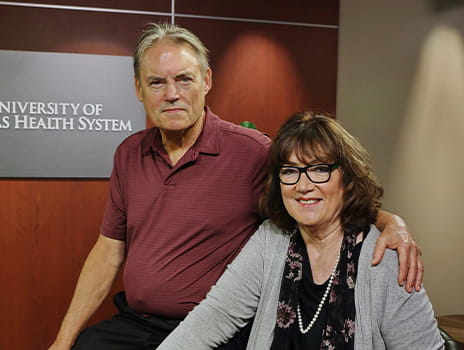October 14, 2019
She had a family history of heart disease and watched her heart health closely. He had no heart problems at all in his family and anticipated no issues of his own. But despite differing histories, Kathleen and Richard Lenz – husband and wife of more than 47 years – found themselves receiving identical cardiac surgical procedures in the same year. They even received the same size replacement valve.
"I always thought we had a really great heart connection, and now it's kind of official," Kathleen says. "We both have stents in the same coronary artery."
It was Richard, 72, who went first. Kathleen – who laughs, "I don't look my age, so I don't tell it." – had been experiencing a slow decline in heart function, but didn't yet need surgery.
On Christmas in 2018, Richard began to cough. By the end of the family's large celebratory dinner, he was coughing nonstop. He decided to go to bed and visit the doctor the next day. When he did, his primary care provider immediately called an ambulance.
"I was shocked to find out it was heart disease," Richard says. "I thought it might be pneumonia. But it was heart disease. My arteries were 70% blocked, and I had problems with my aortic valve."
Richard spent 4 days in intensive care taking medications to reduce fluids in his body. He was soon advised that his only option was open heart surgery.
"I had no experience here myself," he recalls. "I'd been told that open heart surgery brought terrible pain. I thought it was just what I had to do."
But his brother-in-law suggested otherwise. He encouraged Richard to get a second opinion at The University of Kansas Health System.
"Once I make a commitment, I keep it," Richard says. "The surgery was scheduled. It felt strange to get a second opinion, like something that went against my nature."
An appealing option
At Kathleen's urging, the couple visited cardiologist Charles Porter, MD, who introduced TAVR (transcatheter aortic valve replacement), a minimally invasive procedure to replace a narrowed aortic valve that no longer opens as it should.
Dr. Porter called his colleague, cardiothoracic surgeon George Zorn, MD, into the exam room for an opinion. The TAVR procedure was offered as a clinical trial, available at the health system because it is part of an academic medical center. Dr. Zorn thought Richard would be an eligible candidate.
"I said immediately, 'We're doing that!'" Kathleen says. "Doctors use an artery to guide a stent up to the aortic valve. You don't need to open up the chest to correct this. It's a real miracle."
According to Dr. Zorn, aortic stenosis "will occur in all of us if we live long enough," and patients with this common narrowing of the aortic valve opening face a rapid decline in quality of life. Traditionally, open heart surgery is the standard treatment. But it is a treatment that is too invasive for some to receive.
"As a surgeon, that's one of the hardest decisions to make. We know when we see some of these older, frailer patients, the only option for meaningful survival and quality of life is to have the valve replaced, but we know it will be a hard process for them," Dr. Zorn. "TAVR has opened up a whole new world."
After further testing, the doctors confirmed Richard could receive the experimental TAVR procedure. The night after the procedure, Richard was up and walking. He went home the next day. Hungry on the way home, the couple stopped to grocery shop together.
"It was truly astounding," Richard says. "I was shopping for groceries the day after surgery. I didn’t have any pain."
Her turn
After recovery, Richard began cardiac rehab. As he grew stronger, he intensified his exercise plan until he was working out on the elliptical machine almost an hour every day, plus walking with Kathleen on their neighborhood walking paths. Until, that is, Kathleen's own symptoms escalated.
"I couldn't do the walk," she says. "I couldn't do a flight of stairs without shortness of breath. I was dizzy."
She saw Dr. Porter and learned she was now eligible for TAVR in the clinical trial for low-risk patients. She had the procedure on July 17. She also received a pacemaker.
"I'm feeling great now," she says. "My breathing has improved. My lung capacity has improved. I'm walking without feeling dizzy or short of breath and getting back my stamina."
A healthy life
The couple adopted a low-sodium, low-fat, low-cholesterol diet and continued to make exercise a part of every day. Richard lost 52 pounds.
"I feel quite proud of myself," he says.
The Lenzes are grateful for the care they received and the trials available within an academic medical center. They recommend clinical trials to others.
"Trials are fantastic," Richard says. "The field of medicine is always pushing to improve, and how do you get there without trials? They’re phenomenal."
"We're so happy we came here and received guidance from Dr. Porter," Kathleen adds. "Trials are the leading edge of technology and medical treatment. Mick Jagger had TAVR, you know."
"But it doesn't help your singing ability at all," Richard jokes.
It's no laughing matter that Richard and Kathleen have regained their health and look forward to years of happiness with their son and daughter and each other.
"We are a very close family and do a lot together," Kathleen says. "Our kids are glad we're still here. We do like to travel, and we might get back to that, but we have a great life right here. It's OK to just be at home. We have each other."
Opportunity for others
Kathleen and Richard learned exciting news during a recent follow-up appointment for Kathleen. For one thing, her heart health and numbers looked excellent, and for another, interventional cardiologist Mark Wiley, MD, shared an important development.
"This was a big week for us," Dr. Wiley told the Lenzes. "Because of people like you, who participated in the low-risk study, the TAVR procedure has been approved by the FDA. If you would have had your procedure a month from now, it wouldn't have been part of a study. It's a great procedure and a great device, so this is very good to see."
TAVR used to be available for only the severely ill. Now, it is offered to a broader patient population, providing a minimally invasive alternative to open heart surgery. Recovery time is shorter and quality of life is more quickly reclaimed.
"Open surgery is still a very good option for a lot of patients," Dr. Zorn adds. "They do very well, and 4-6 weeks out, they're past the surgery and back to living their lives. But with the TAVR patients, when you come in in the afternoon after their morning surgery, they're already saying, 'I can tell the difference, doc. I'm walking easier. I'm breathing easier.' And that's a pretty cool thing."
The Lenzes agree.
"We have had excellent care," Kathleen says. "It has been exceptional. Everyone has treated us so well, from the doctors to the nurses to the janitors. We are so happy with this hospital."

Leading research and clinical trials
As part of one of the nation's premier academic medical centers, our care providers are committed to research and scientific discovery through the University of Kansas Medical Center. We can often include our patients in potentially lifesaving clinical trials and treatment options not available anywhere else.
This individual participated in a clinical trial of an investigational treatment. Clinical trials are different from standard medical care. As with all research studies, clinical trial participant outcomes vary. Before participating in a clinical trial, it is important to discuss the risks and benefits with your healthcare provider.





